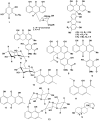Medicinal plants used in traditional treatment of malaria in Ethiopia: a review of ethnomedicine, anti-malarial and toxicity studies
- PMID: 36088324
- PMCID: PMC9463824
- DOI: 10.1186/s12936-022-04264-w
Medicinal plants used in traditional treatment of malaria in Ethiopia: a review of ethnomedicine, anti-malarial and toxicity studies
Abstract
Background: Malaria is extremely common in Ethiopia, and it is one of the country's most serious public health and economic problems. Traditional medicines have long been utilized in Ethiopia by people of various ethnic groups. As a result, the goal of this study is to record the use of Ethiopian medicinal herbs that have been used to treat malaria. Also, a critical review of the literature on the therapeutic properties of these and other Ethiopian medicinal plants that have been tested against Plasmodium spp. parasites was conducted with the goal of highlighting neglected studies and fostering further research in this area.
Methods: A comprehensive literature search was performed in Scopus, Web of Science Core Collection, PubMed, Science Direct, Google Scholar, and Scientific Electronic Library Online (SciELO) from August 2021 to October 2021. The study databases included original articles published in peer reviewed journals covering anti-malarial plants, dated until October 2021.
Results: The review looked at 51 plant species (28 families) that have been used to treat malaria in Ethiopia. The most often used ethnobotanical plant species for the treatment of malaria were Allium sativum, Croton macrostachyus, Carica papaya, and Lepidium sativum. Leaves were used more frequently as a therapeutic preparation than other parts. Plant extracts were found to have very good, good, and moderate anti-malarial activity in mice with rodent Plasmodium species. The most active species were Ajuga remota and Capsicum frufescens, which suppressed parasitaemia by 77.34% and 72.65%, respectively, at an oral dose of 100 mg/kg and an LD50 of above 2000 mg/kg. The compound Aloinoside reported from Aloe macrocarpa leave latex was the most potent; it suppressed parasitaemia by 100% at 400 mg/kg oral dose of Plasmodium berghei infected mice, and its LD50 was above 2000 mg/kg. Toxicity was shown to be safe in 84% of the plant extracts.
Conclusion: In Ethiopia, medicinal plants have a significant part in reducing the severity of malaria due to their widespread use. As a result, more studies are needed to identify and develop effective novel drugs that could be employed in broader malaria eradication efforts.
Keywords: Antimalarial; Ethiopia; Ethnomedicine; Medicinal plants.
© 2022. The Author(s).
Conflict of interest statement
The authors declare that they have no known competing financial interests or personal relationships that could have appeared to influence the work reported in this paper.
Figures
References
-
- Nankabirwa JI, Yeka A, Arinaitwe E, Kigozi R, Drakeley C, Kamya MR, et al. Estimating malaria parasite prevalence from community surveys in Uganda: a comparison of microscopy, rapid diagnostic tests and polymerase chain reaction. Malar J. 2015;14:528. doi: 10.1186/s12936-015-1056-x. - DOI - PMC - PubMed
-
- WHO. World Malaria Report. Geneva, World Health Organization, 2020; Available from: https://www.who.int/news-room/fact-sheets/detail/malaria. Accessed 30 Sept 2021.
Publication types
MeSH terms
Substances
LinkOut - more resources
Full Text Sources
Medical
Research Materials
Miscellaneous



